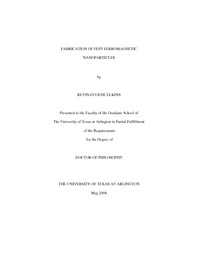
ATTENTION: The works hosted here are being migrated to a new repository that will consolidate resources, improve discoverability, and better show UTA's research impact on the global community. We will update authors as the migration progresses. Please see MavMatrix for more information.
Show simple item record
| dc.contributor.author | Elkins, Kevin Eugene | en_US |
| dc.date.accessioned | 2008-08-08T02:31:14Z | |
| dc.date.available | 2008-08-08T02:31:14Z | |
| dc.date.issued | 2008-08-08T02:31:14Z | |
| dc.date.submitted | April 2008 | en_US |
| dc.identifier.other | DISS-2065 | en_US |
| dc.identifier.uri | http://hdl.handle.net/10106/971 | |
| dc.description.abstract | Fabrication of chemically disordered FePt particles ranging from 2 - 9 nm with a precision of 1 nm has been achieved through modification of key process variables including surfactant concentration, heating rates and the type of iron precursor. In addition, the shape evolution of the FePt nanoparticles during particle growth can be manipulated to give cubic or rod geometries through changes to the surfactant injection sequence and solvent system. The primary method for synthesis of the disordered FePt nanoparticles is the polyol reduction reported by Fievet et al., which has been modified and used extensively for synthesis of diff ering nanoparticle systems. Our procedures use platinum acetylacetonate, iron pentacarbonyl or ferric acetylacetonate as precursors for the FePt alloy, oleic acid and oleyl amine for the surfactants, 1,2-hexadecanediol to assist with the reduction of the precursors and either dioctyl ether or phenyl ether for the solvent system. For iron pentacarbonyl based reactions, adjustment of heating rates to reflux temperatures from 1 - 15 oC per minute allows control of FePt particle diameters from 3 - 8 nm. Substitution of iron pentacarbonyl with ferric acetylacetonate as the iron source results in 2 nm particles. A high platinum to surfactant ratio of 10 to 1 will yield 9 nm FePt particles when iron pentacarbonyl is used as the precursor. For use of these particles in advanced applications, the synthesized particles must be transformed to the L1o phase through annealing at temperatures above 500oC. Inhibition of particle sintering can be avoided through dispersion in a NaCl matrix at a weight ratio of 400 to 1 salt to fcc FePt particles. Production of L1o FePt nanoparticles with high magnetic anisotropy with this process has been successful, allowing the original size and size distribution of the particles. | en_US |
| dc.description.sponsorship | Liu, J. Ping | en_US |
| dc.language.iso | EN | en_US |
| dc.publisher | Materials Science & Engineering | en_US |
| dc.title | Fabrication Of FePt Ferromagnetic Nanoparticles | en_US |
| dc.type | Ph.D. | en_US |
| dc.contributor.committeeChair | Liu, J. Ping | en_US |
| dc.degree.department | Materials Science & Engineering | en_US |
| dc.degree.discipline | Materials Science & Engineering | en_US |
| dc.degree.grantor | University of Texas at Arlington | en_US |
| dc.degree.level | doctoral | en_US |
| dc.degree.name | Ph.D. | en_US |
| dc.identifier.externalLink | https://www.uta.edu/ra/real/editprofile.php?onlyview=1&pid=4898 | |
| dc.identifier.externalLinkDescription | Link to Research Profiles | |
Files in this item
- Name:
- umi-uta-2065.pdf
- Size:
- 16.92Mb
- Format:
- PDF
This item appears in the following Collection(s)
Show simple item record


